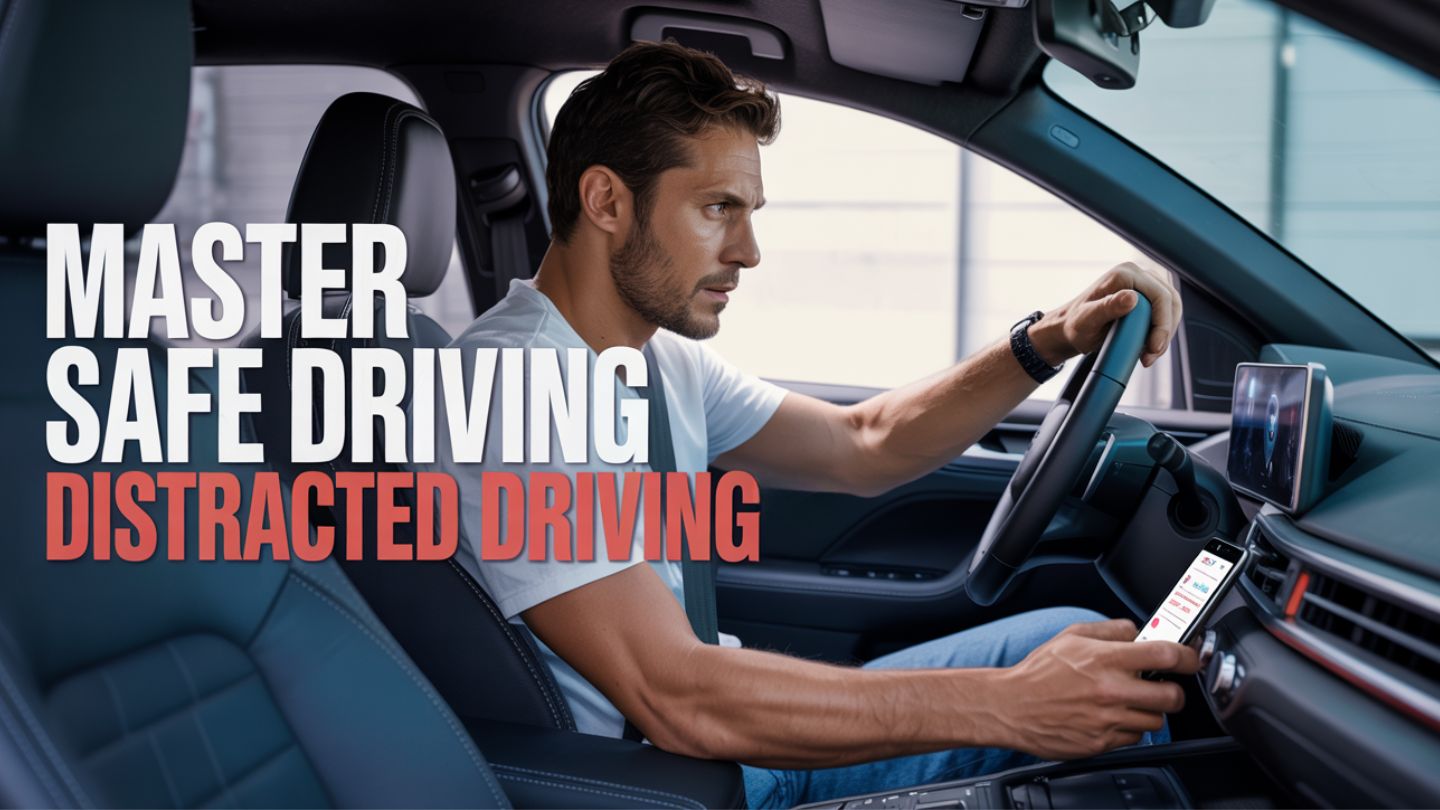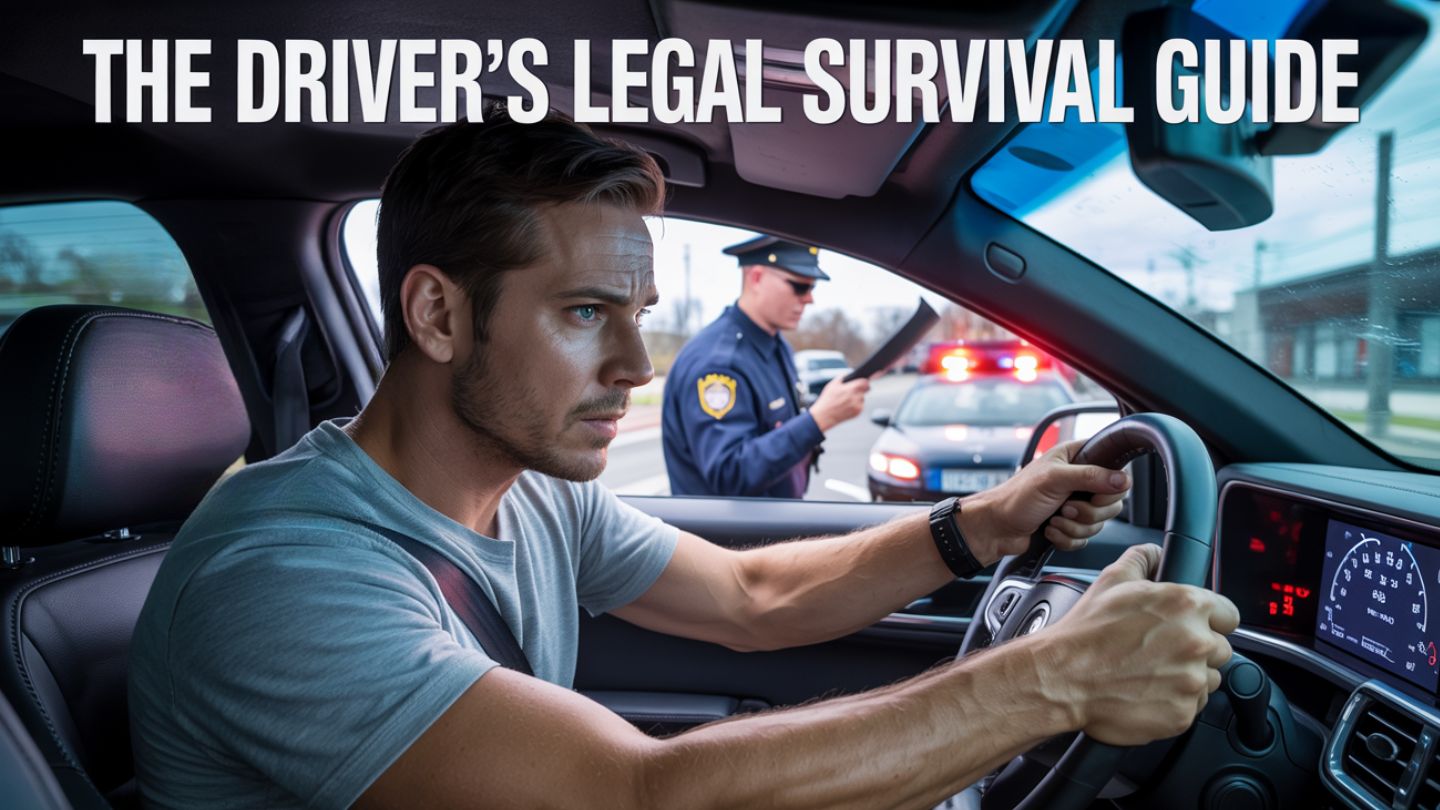Want to pass your road test on the first try? Mastering defensive driving is the key. This blog shares essential defensive driving tips to help you pass your road test, covering techniques like maintaining a safe following distance, using turn signals properly, and handling emergency situations. Get ready to boost your confidence and drive safely.
Key Takeaways
- Applying defensive driving techniques, including the SIPDE method, significantly increases the chances of passing a road test and enhances overall driving safety.
- Practicing safe habits such as maintaining a safe following distance, using turn signals, obeying traffic signals, and scanning the road improves response times and traffic awareness.
- Final preparations for the road test should include familiarizing oneself with the test route, reviewing the driver’s manual, and taking practice tests to boost confidence and readiness.
Essential Defensive Driving Techniques for Road Test Success
Understanding the five skills taught in a defensive driving class can transform how you handle real-world driving scenarios. From hazard recognition to safe following distances, these essential techniques help reduce accidents, build confidence, and make you a more responsible driver.
Knowing and applying defensive driving techniques can significantly enhance your chances of passing your road test. These include anticipating potential dangers, making informed decisions, and practicing safe driving habits. The SIPDE method (Search, Identify, Predict, Decide, Execute) effectively improves reaction times and decision-making skills, which are essential skills for the test. Effective scanning allows detection of potential hazards early, enabling safe reactions.
Being aware of your surroundings and anticipating hazards significantly reduces collision risks. Moreover, practicing the management of unforeseen circumstances prepares you for challenges like road rage and bad weather, which are often part of real-world driving scenarios. These defensive driving techniques are not just important for passing the DMV test but also for evaluating your driving behavior and ability to handle real-world situations.
When you master these techniques, you become a proactive and aware driver, which increases your confidence and boosts the likelihood of a successful road test outcome. Not only does this enhance your safety, but it also contributes to a responsible driving record, making you a safer driver overall.
Maintain a Safe Following Distance
Keeping a safe following distance is a key defensive driving practice that ensures safety on the road. It provides ample time to react to sudden changes in traffic conditions. The recommended minimum safe following distance during dry weather conditions is at least the three second rule. This distance allows you to react promptly to any sudden stops or unexpected situations on the road. By keeping enough space between your vehicle and the vehicle ahead, you improve your reaction time and create room for emergency maneuvers, enhancing overall safety.
This practice is particularly crucial during night driving and in adverse weather conditions, where reduced visibility and increased braking distance demand greater caution. Adjust speed according to traffic conditions and following distance ensures you have enough space to react at a safe speed.
This practice not only helps avoid accidents but also makes you a more responsible driver and a safe driver, adhering to traffic laws and promoting road safety. Remember to drive safely.
Proper Use of Turn Signals and Blind Spot Checks
Using turn signals and checking blind spots are vital for safe driving and clear communication with other motorists. Key points include:
- Signal at least 100 feet before changing lanes or turning to make your intentions clear to others.
- This simple action can prevent accidents.
- Making your driving behavior predictable is critical for avoiding rear-end collisions and other types of crashes.
Always check your blind spots before changing lanes by checking your mirrors and glancing over your shoulder to ensure the lane is clear of other vehicles. This helps avoid potential collisions, making you a safer and more responsible driver. Remember to change lanes only when it is safe to do so.
Remember to slow down appropriately before turning and stay in your traffic lanes straight ahead to avoid common mistakes that can lead to accidents.
Obey Traffic Signals and Stop Signs
Following traffic signals and stop signs is fundamental to defensive driving. Adhering to these rules ensures safe driving and prevents accidents, while ignoring them can lead to serious consequences and legal penalties. As a responsible driver, always obey traffic signals and stop signs to maintain traffic flow and avoid collisions.
When approaching a stop sign or red lights, make a complete stop and check for oncoming traffic before proceeding. This practice not only ensures your safety but also the safety of other road users. By consistently following traffic laws, traffic lights, and signals, you demonstrate good driving behavior, which is essential for passing your road test and becoming a safer driver.
Read More: Defensive Driving vs. Basic Traffic School
Mastering Real-World Driving Scenarios

Mastering real-world driving scenarios is essential for passing the road test and becoming a competent driver. Key strategies include:
- Planning your route in advance to reduce the likelihood of sudden lane changes and stops, which can cause accidents.
- Becoming familiar with the test route to reduce anxiety and improve performance during the actual driving test.
- Expecting the unexpected, such as waiting a moment after a traffic light turns green, to prevent crashes by allowing you to anticipate potential dangers.
Real-world driving scenarios often involve varied traffic conditions and behaviors from other drivers. Practicing defensive driving techniques helps prepare you for these situations, significantly enhancing your confidence and readiness for the road test through defensive driving training.
Navigating Intersections Safely
Navigating intersections safely is critical for any driver. When approaching an intersection, slow down and check for oncoming traffic from both directions. This helps you anticipate potential hazards and react appropriately, ensuring everyone’s safety. Always check for cyclists and motorcyclists at intersections, as they are more vulnerable and may be harder to see.
Yield signs indicate that you should slow down and prepare to stop if necessary. By following these traffic rules, you can navigate intersections more safely and avoid accidents. This practice not only helps you pass your road test but also makes you a more responsible and safer driver in real-world driving scenarios, including understanding each road sign.
Handling Aggressive Drivers
Dealing with an aggressive driver can be challenging, but staying calm helps defuse tense situations. Keep a safe distance from many drivers and other driver aggressive drivers to avoid confrontations and accidents. Focus on aggressive driving safely and avoid engaging with them.
By practicing these defensive driving techniques, you can handle aggressive drivers more effectively and maintain control of your driving environment. This not only helps you pass your road test but also promotes road safety and responsible driving behavior, enhancing drivers defensive driving. Additionally, being among the defensive drivers can further improve your defensive driving skills, making you a more skilled defensive driver.
Read More: Key Differences Between Defensive and Aggressive Driving
Driving in Bad Weather Conditions
Driving in bad weather requires special attention and adjustments. In adverse conditions like rain, lower your speed and increase following distance to maintain better control of your vehicle. This helps you react more safely to sudden changes and avoid accidents.
Smooth application of brakes is essential in bad weather to maintain vehicle stability and prevent skidding. Gradual braking helps ensure a smooth stop and reduces the risk of losing control.
By practicing these defensive driving techniques, you can handle bad weather conditions more confidently and safely.
Enhancing Vehicle Control and Awareness

Enhancing vehicle control and situational awareness is crucial for passing your road test and becoming a competent driver. Key points include:
- Smooth steering involves gentle movements and proper hand positioning to maintain vehicle control.
- Using the push-pull or hand-over-hand steering methods ensures better vehicle handling.
- Applying knowledge to real-world situations during a road test helps convert theoretical understanding into practical execution.
- Practicing driving in diverse conditions can significantly enhance your confidence and readiness for the road test.
Regular maintenance checks on your vehicle’s brakes, lights, and battery can prevent mechanical failures, ensuring your vehicle is in optimal condition for the road test.
Smooth Steering Wheel Movements
Smooth steering is crucial for maintaining control and avoiding abrupt maneuvers. Demonstrating precise handling through smooth steering indicates good driving skills behind the wheel during the road test. Use both hands on the wheel and practice hand-over-hand technique for optimal control.
Practice turning at intersections and maintaining a steady speed as you steer to help ensure smooth movements. Engage in exercises that involve practicing smooth steering in various driving situations, like navigating curves, to enhance your vehicle control skills.
Effective Braking Techniques
Effective braking is essential for maintaining control and ensuring safety. Gradually slowing down prevents wear on brake pads and helps maintain control. Controlled braking is crucial in areas with speed limit changes or hazards, allowing for smooth speed reduction.
Key points about braking and vehicle control include:
- Cover braking involves hovering your foot over the brake pedal to prepare for a stop without abrupt pressure.
- Downshifting when approaching a decline can help slow the vehicle without overworking the brakes.
- Avoid sudden stops as they can lead to loss of vehicle balance and potential collisions.
By mastering these braking techniques with guidance from experienced instructors, you can pass your road test with confidence and ensure safe driving in real-world scenarios.
Constantly Scanning the Road Ahead
Constantly scanning the road ahead, behind, and beside enhances situational awareness and helps identify potential hazards. Regularly scanning your environment and looking at least ten seconds ahead allows you to spot dangers early and take appropriate action, such as slowing down, changing lanes safely, or increasing following distance while being aware of the vehicle in front.
Effective scanning allows drivers to react promptly to emerging dangers on the road, making you a safer driver. This practice is essential for passing your road test and ensuring road safety in real-world driving scenarios.
Read More: How Defensive Drivers Can Manage and Reduce Road Rage
Preparing for Emergency Situations

Preparing for emergency situations is crucial for handling unexpected incidents on the road confidently. Familiarity with emergency procedures can significantly reduce risks. Key points include:
- Practicing smooth steering to improve vehicle control and manage unexpected situations.
- Recognizing that car fires can be caused by electrical problems.
- Moving away from the vehicle immediately if a fire occurs.
By being prepared for emergencies, you can manage potential dangers more effectively and ensure your safety and that of other road users while anticipating potential hazards.
Handling Mechanical Failures
Handling mechanical failures requires a calm and informed approach. In the event of brake failure, pump the brakes if your vehicle lacks an anti-lock system. Safely steer off the road and use the emergency brake to control the situation. Threshold braking involves applying maximum pressure on the brakes without locking the wheels during emergencies.
During a tire blowout, maintain a firm grip on the steering wheel and gradually reduce speed without abrupt braking. Regular vehicle maintenance can reduce the risk of experiencing mechanical failures while driving, ensuring your vehicle is in optimal condition.
Responding to Traffic Crashes
Responding to traffic crashes requires a composed and systematic approach. If involved in a crash, follow these steps:
- Ensure your safety by moving to a secure location if possible.
- Stay calm.
- Check for injuries.
- Call emergency services if necessary.
Gather information from all parties involved in the crash, including names, insurance details, and vehicle information. This information is crucial for any follow-up actions and for reporting the accident to the authorities and insurance companies.
Properly responding to traffic crashes not only helps you manage the immediate situation but also ensures a smoother resolution process.
Using Escape Routes and Space Cushions
Using escape routes and maintaining space cushions are essential defensive driving techniques. Escape routes provide a clear path to avoid potential collisions, allowing quick maneuvering in case of a hazard. Escape ramps, typically constructed with loose, soft materials like pea gravel or sand, safely stop runaway vehicles.
By keeping enough space between your vehicle and others, you create a space cushion that allows you to react to other drivers’ errors and avoid accidents. Being aware of these safety measures and using them effectively can help you prevent accidents and ensure your safety on the road.
Final Preparations for Your Road Test
As your road test approaches, make final preparations to ensure you are ready and confident:
- Adjust your seat, mirrors, and steering wheel for comfort and visibility.
- Master the Georgia Driver’s Manual.
- Utilize practice tests to improve your readiness for the written exam.
Familiarizing yourself with the test route can significantly boost your confidence and preparation for the road test. By driving a different route at different times, you can become aware of varying traffic conditions and potential obstacles, making you more adaptable and prepared for the actual test.
Revisit the test route multiple times to gain comfort and familiarity before your road test.
Review the Driver’s Manual
Thoroughly reviewing the driver’s manual is crucial for understanding the latest traffic laws and road signs, which is critical for safe driving. The Georgia Driver’s Manual serves as a foundation for the written test, ensuring that drivers are knowledgeable about essential road rules.
By studying the manual, you can familiarize yourself with the rules and regulations that will be tested, giving you the confidence to pass both the written and road tests. This preparation is not only necessary for the test but also contributes to your overall driving knowledge and safety on the road.
Take Practice Tests
Taking online practice tests effectively simulates the road test experience and improves your confidence. Practice tests help assess your overall readiness and identify areas needing additional practice or improvement.
Make it a habit to regularly take online practice tests to consistently monitor your progress and boost your skills. This continuous practice will help you become more familiar with the test format and reduce anxiety on the day of your road test.
Get Comfortable with the Test Route
Familiarizing yourself with the test route can significantly boost your confidence and preparation. Driving the route at different times helps you become aware of varying traffic conditions and potential obstacles, making you more adaptable and prepared for the actual test.
Practicing specific maneuvers, such as turns and parallel parking, at locations along the test route will make these actions more automatic. Revisit the test route multiple times to gain comfort and familiarity before your actual road test. This preparation will help you feel more confident and ready when it’s time to take the test.
Read More: What Are The Top Five Skills Taught in a Defensive Driving Class?
Final Thoughts
Mastering defensive driving techniques is essential for passing your road test with confidence. By keeping a safe following distance, signaling correctly, and obeying traffic rules, you show responsible driving habits. Practicing real-world scenarios like navigating intersections, driving in bad weather, and staying calm in emergencies boosts your preparedness and overall safety behind the wheel.
At Court Approved Defensive Driving, we’re here to help you succeed with our Texas approved driving safety course online. From comprehensive driving tips to road test preparation, our course gives you the tools to become a safe, skilled, and confident driver. Have questions? Contact us today to learn more.
Frequently Asked Questions
What are the steps to complete the Texas Defensive Driving Course?
To complete the Texas Defensive Driving Course, you must first register online, then finish the course at your own pace, and finally obtain your certificate. Following these steps will ensure you meet the necessary requirements efficiently.
What type of certificate is provided upon completion of the course?
Upon completion of the course, a PDF certificate of completion is provided.
What topics are covered in the Texas Defensive Driving Course?
The Texas Defensive Driving Course covers important topics including hazard recognition, accident prevention techniques, and safe driving practices. Completing the course can enhance your driving skills and promote overall road safety.
How often can you take a defensive driving course for ticket dismissal in Texas?
You can take a defensive driving course for ticket dismissal in Texas once every 12 months. This can help keep your driving record clear and potentially lower your insurance rates.
What is the benefit of completing the Texas Defensive Driving Course?
Completing the Texas Defensive Driving Course can effectively dismiss a traffic ticket and potentially lower your insurance premiums. This course not only enhances your driving skills but also provides financial benefits.



